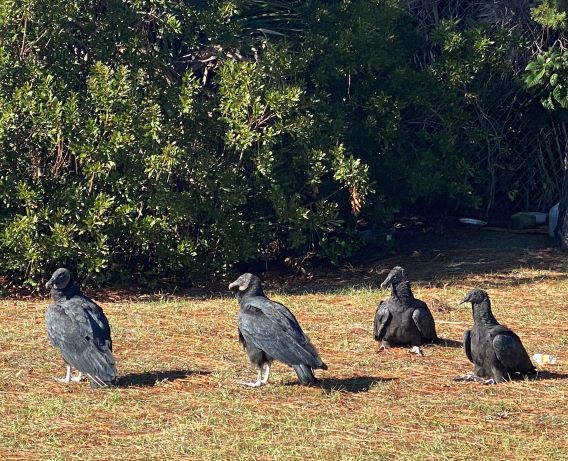By Pat Foster-Turley, Ph.D.
January 13, 2022

This isn’t the first time I’ve written about the Joe Carlucci Sisters Creek Boat Ramp on Heckscher Drive and I’m sure it won’t be the last. Since the beginning of the pandemic, when inside activities were curtailed for Bucko and me, we’ve been making pilgrimages to this parking lot to watch nature. And with all things that become routine, we’ve gotten deeper and deeper into the goings on there.
We started out sitting opposite the BAE facility, watching the progress on various ships being worked on there. And much of the time we see dolphins in the channel and out in the St. Johns River, sometimes even jumping high in behaviors we called “bows” and “spyhopping” back in our old Marine World days. Sometimes we even see groups of dolphins (called “pods”) interacting with lots of rough splashing. Seeing them in the wild like this, and not in a pool, is a real pleasure.
Often we also see other groups of animals that share this parking lot with us. Take the wood storks, for instance. These days, more often than not, these “musters” of a group of storks hang out at the boat ramp lot, looking like a scruffy bunch of thugs. These wood storks primarily eat fish and other small aquatic creatures that they can find along the shore.
And then there are the vultures, both black ones and turkey vultures, together or in separate groups. When these vultures are feeding on a carcass they are called a “wake” which brings to mind images of mourners at a funeral. Occasionally we see them eating a carcass, most often a possum, in the parking lot. And, no doubt when any of the resident feral cats at the boat ramp expires they will feed on them too. For now the vultures happily coexist with the cats and come in to eat left over dry cat food and to scavenge food remains from the garbage cans placed around the area. When the vultures are not feeding, but resting on the grass, they are called a “committee” and when flying, a “kettle”. Who knew?
Competition for the contents of the garbage cans (with remains of human picnics, and fisherman’s cast offs) is fierce. Flocks of boat-tailed grackles (a “plague”), starlings (a “clattering”) and sometimes crows (a “murder”), also hang out in the area and yank food items from the cans to eat on the lawn. But they can hardly compete with the large groups of sea gulls (a “colony”) also gathered here looking for enticing bits of trash.

But of course our favorite gang of animals at the boat ramp are the feral cats, known to some as a “clowder”. These creatures have been captured, neutered and released back into their wild home by a dedicated but informal group of volunteers, like us. There are two clowders at the boat ramp, one by the gate and another by the dumpster at the far end of the parking lot. These cats are not tame, not pettable for the most part, and are adjusted to a life in the wild. But at the boat ramp their life is not so difficult at all. One man visits every couple of days to refill their water bowls, and to leave jugs of water around for the rest of us to use to fill the bowls again if they are empty. Other people, like us, bring food. There is no volunteer coordination and sometimes when we visit the cats their bowls are full and the cats are not very interested in mundane food offerings. At these times I pull out cat treats for them—hey there’s always room for dessert right?
And of course there are other groups of animals at the boat ramp too, and that is us and others like us that visit regularly for the scenery, the nature, the fresh air, and the drive down Heckscher. We watch fishermen, picnickers, boaters, bird watchers, and all kinds of other groups of people. Some people come to feed the sea gulls; others feed the cats; some picnic there, some launch their boats, some fish from shore–there’s always something going on in the human world too. And groups of people, whatever you call them, are always there and fun to watch too!
Pat Foster-Turley, PhD is a zoologist on Amelia Island. She welcomes your nature questions and observations. [email protected]

That boat ramp is, indeed, a great place to see a wide variety of birds and other animals. But, please, do not feed the feral cats! I know it might seem cruel, but those are wild animals, too, and they are the number one killer of songbirds around there. Please treat them as you would any other wild animal, and don’t feed them, and let nature take it’s course with them.
Hi Mark. Thanks for your comment which I generally agree with. My own cat is indoor only. But the cats mentioned here are all neutered, most are aged and have lived here for years. The colonies are dying out; nature is taking its course with these old cats. The real education is to people not to drop more cats outside here or anywhere else for that matter. The ones here now are well fed by volunteers and I havent seen any evidence of predation on birds. It is a parking lot where these cats live, mostly house sparrows, grackles, etc. So I’m not worried about the biodiversity or ecological harm that these particular cats do.
Thanks Pat, i didn’t know there were all those names for groups of animals…..actually I think Herd and Flock were my total vocabulary.
What a fun article! Thanks for the education Pat. I always enjoy your adventures